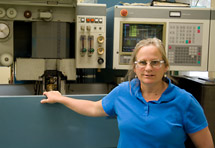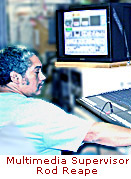Annual Ultrafast X-ray Summer School at SLAC This Week
Post-docs and students from around the world gather this week at SLAC for the annual Ultrafast X-ray Summer School. (Click on image for larger version.)
by Brad Plummer
This week a gathering of students and post-docs from around the world arrived at
SLAC for the 2008
Ultrafast X-ray Summer School, hosted by the Photon Ultrafast Laser Science and Engineering (PULSE) center. The annual residential summer school is geared toward opening the world of ultrafast laser research to new scientists.
The meetings, held in SLAC's Kavli Auditorium June 17-20, aim to provide
information about scientific opportunities in ultrafast science with a special
emphasis on the world's new X-ray free electron laser facilities. Interactive lectures
are being presented by expert scientists in a variety of fields, including coherent X-ray imaging, high energy density science, magnetism and chemical dynamics.
The PULSE center focuses its research in part on SLAC's new X-ray source, the Linac Coherent Light Source, now under construction and scheduled to begin operation in 2009.
|

Denise Larsen
Knows Her Stuff
by Calla Cofield

Denise Larsen in the Light Fab shop. (Click on image for larger version.) Denise Larsen knows her stuff. She's been a machinist for over 20 years, and genuinely loves it. Her know-how is what has earned her respect from her coworkers, and she says it's that mutual respect that keeps the shop running.
More than 20 years ago, Larsen was working her way through school when a chance encounter in a machine shop changed her life. Her eyes light up when she talks about it. "I had a friend, a woman, who was working in a shop with her father and brothers. She showed me the shop and I just thought, 'Hey! This looks like fun!'"
Larsen took several machine classes at her college before enrolling in a machinist training program at NASA-Ames.
After training at NASA, SLAC was a good fit for Larsen. She began working as a machinist in the Central Lab machine shop, was promoted to supervisor, and later moved to the Light Fabrication machine shop as a supervisor. At that time, she was met with some resistance. "I hadn't worked as a machinist in that shop before I became supervisor, so they didn't know if I knew what I was doing. And there were a few people—not everyone—who didn't want a woman working in the shop, let alone to be working for one," she recalls.
Now, Larsen says, that old attitude is gone. She and her coworkers have a strong sense of respect for one another and work closely as a team. "The whole culture has changed and the shop is a respectful workplace."
The machine shop is responsible for some of the specially designed parts needed at SLAC. Larsen says they'll build or fix everything from parts of the accelerator to parts for air conditioners. "We deal with metal, ceramic, all kinds of materials. And just about everyone here can work on most of the machines. In most shops people work on just one machine for years."
Outside of work, most of Larsen's time is dedicated to her kids. When her 9-year-old son wanted to race sailboats but couldn't find a local team, Larsen and her husband organized one. Now, they drive along the coast almost every weekend heading to races. She says it's just like organizing Little League: only for this sport she and her husband drive as far north as Oregon, with a trailer carrying as many as six small sailboats. And when the hustle and bustle of sailing competitions is done, you can find Larsen enjoying a little quiet time in her garden.
|
Multimedia Services Offers
New Online Event Request Form
by Kelen Tuttle
 SLAC's
Multimedia Services provides an entire suite of video production
services for the Panofsky Auditorium conference facility as well as for
meetings and events site-wide. These services include: SLAC's
Multimedia Services provides an entire suite of video production
services for the Panofsky Auditorium conference facility as well as for
meetings and events site-wide. These services include:
• audio
production/microphones
• video production
• video taping
• large-screen
projection of video and computer presentations
• maintenance on A/V
conference and meeting room equipment on the SLAC campus
• A/V equipment
consultations
• tape-to-DVD transfers
• DVD duplication It is now
possible to request these services using an online
Multimedia Services Event Request Form. For meetings and events,
arrangements should be made at least one week in advance. This will allow
Multimedia Services time to schedule the technician(s) and equipment.
Conservation Tip
of the Week: Plants for Dry Conditions
by John Steward
I was working in the backyard this past weekend and noticed what an extreme
effect our decision to stop irrigating has had on our yard. I thought "What Next?" and
realized that I really don’t have a replacement plan in place.
Sound familiar?
I knew that I should be planting drought tolerant species, but it can be
difficult to know which plants will really look good while I'm conserving water and energy.
So I did a little research and this is what I found:
Perennial flowering plants that tolerate dry conditions include numerous herb species such as
lavender, artemisia, sage and yarrow. Many varieties of these plants have attractive, fragrant, silvery foliage in addition to colorful flowers that are attractive to hummingbirds and butterflies. Sedum,
sunflowers and a species of coneflower, liatris, do very well in sunny, dry locations too.
Colorful annuals that thrive in dry conditions include portulaca (a low growing plant that reseeds itself and produces masses of flowers in nearly all colors),
vinca
(which has shiny leaves and flowers in white, pink or lavender) and the California
poppy. These varieties work well as a border plantings along hot sunny walkways.
Some shrubs that tolerate dry conditions include many species of junipers, some species of
cotoneaster, pyracantha, potentilla and caragana. Many of these shrubs have berries that are both attractive and provide food for wildlife.
A local nursery can recommend draught-tolerant plants for your area. There are many locally adapted native plants that will withstand dry conditions and enhance your landscape for wildlife. Always look to improve your landscaping with
drought tolerant species and help reduce your impact on the environment.
|
Events
Lab Announcements
Community Bulletin Board
|





 <%
Response.AddHeader "Last-modified", getArticleDate()
'Response.AddHeader "Last-modified","Mon, 01 Sep 1997 01:03:33 GMT"
'Monday, December 06, 2010
%>
<%
Response.AddHeader "Last-modified", getArticleDate()
'Response.AddHeader "Last-modified","Mon, 01 Sep 1997 01:03:33 GMT"
'Monday, December 06, 2010
%>